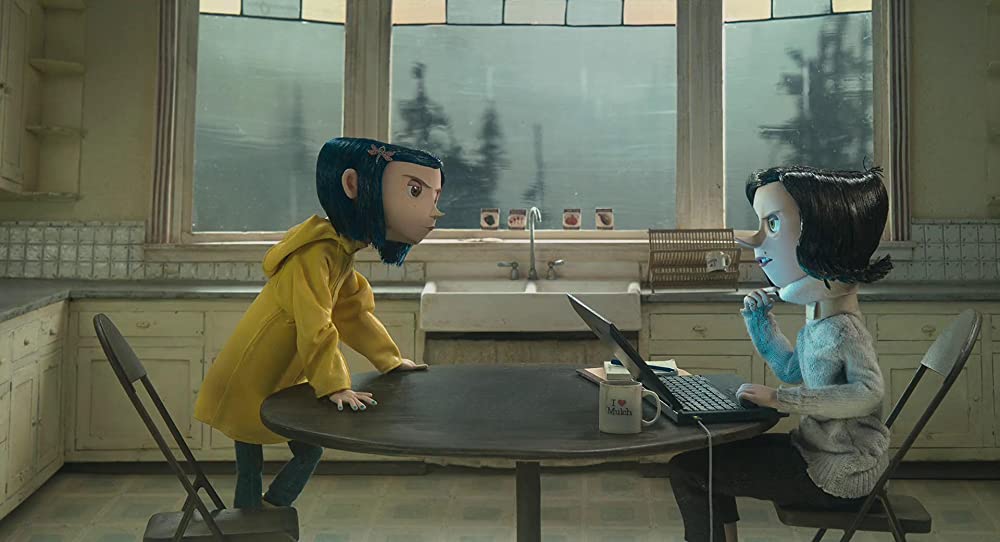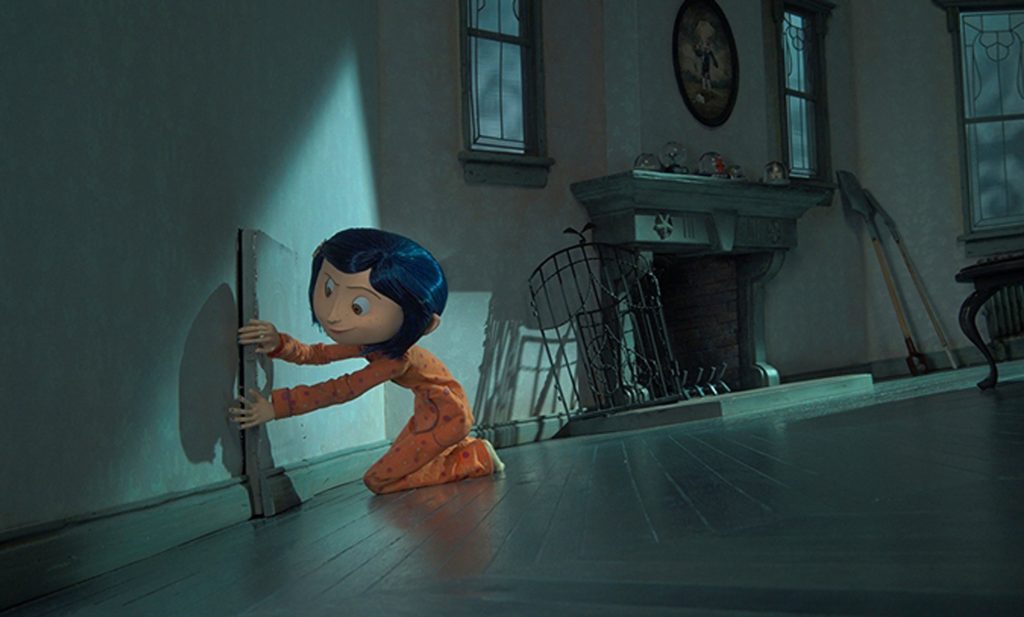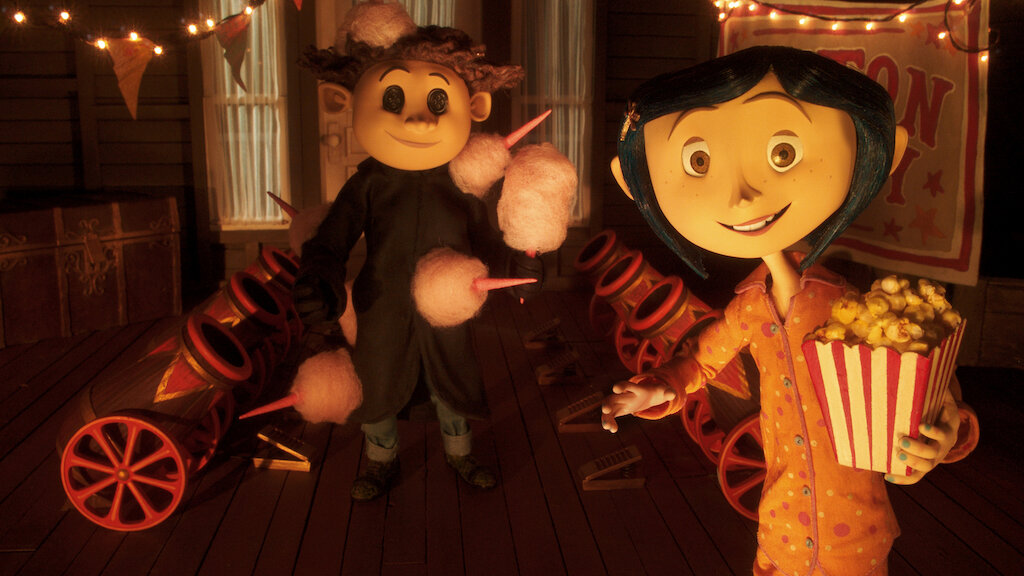
Cassondra Feltus is a St. Louis-based freelance writer best known…
In 2009, LAIKA Studio released its first stop-motion feature, Coraline, written-directed by the incredibly imaginative Henry Selick (The Nightmare Before Christmas). The adaptation is based on Neil Gaiman’s (The Sandman) 2002 novella of the same name, about a lonely girl who falls into a dreamy world that’s both exciting and scary. The delightfully dark fairy tale blends horror elements with family-friendly fun. Almost 14 years later, Coraline is still relevant and beloved.

The Jones family moves from Pontiac, Michigan to a big pink Victorian house, aka the Pink Palace Apartments, in somewhat rural Oregon. Coraline (Dakota Fanning) is an adventurous, supremely unhappy 11-year-old girl who clearly didn’t want to move. Her exhausted parents, Mel (Teri Hatcher) and Charlie (John Hodgman) write about gardening for a living.
They are overworked, grumpy, and dismissive, spending most of the film fretting over writing deadlines. (Just as we millennials started to identify more with Squidward than Spongebob, her stressed-out parents are sadly pretty relatable.) To Coraline, the only thing the adults are super busy with is being miserable and boring.

The old house is drab, made up of muted colors and cobwebs. Coraline stands out with her electric blue hair and wardrobe filled with bright oranges and yellows.
She is endlessly curious and painfully bored, but she’s actually surrounded by some interesting people. The downstairs neighbors are two aging former actresses, April Spink (Jennifer Saunders) and Miriam Forcible (Dawn French), with sing-songy voices and multiple living and deceased Scottish terriers. Upstairs is Mr. Bobinsky (Ian McShane), a former circus performer who trains jumping mice. None of them get her name right, but they give her cryptic warnings.

While out exploring the grounds, she comes across a slinky black cat and meets its sort of owner, the landlord’s grandson Wyborne “Wybie” Lovat (Robert Bailey Jr.), the only one kid around. Coraline finds him both annoying and intriguing. Wybie isn’t a character from the book — he was created just for the film. He’s really only there so that she’s not talking to herself — and to give her a creepy doll with her likeness.

After wandering around her new home, Coraline finds a small door that opens to a brick wall. But at night, it becomes a portal to a parallel universe where it’s always nighttime with glowing lights and warm and dreamy colors. Though she’s initially wary of the two much happier, button-eyed versions of her parents, she starts to enjoy herself once she sees that this world revolves around her.
Literal gravy trains, mango milkshakes on demand (ick), and even wackier versions of her eccentric neighbors keep Coraline consistently awed and entertained. The Other Mother made sure Other Wybie couldn’t talk, which is more than disturbing.
But Coraline is too distracted by the Other Mother’s love bombing to care that much. The Other Cat becomes her world-hopping companion, and here he can talk (in Keith David’s lovely and distinct voice).

Returning to the dull real world only intensifies Coraline’s already restless nature. However, each time she goes back through that door, the Other-verse seems off. Then when she learns what’s required to stay there, she’s not down with it at all.
Things become even more surreal when the Other Mother doesn’t get what she wants, and all the fantastical “otherness” progressively crumbles, making the atmosphere less lively (almost like when Westview got all glitchy in WandaVision). Reality can be a bummer, but the fantasy world comes at a cost.
The Other Mother’s terrifying true form, referred to as the Beldam, is a sharp and pointy spider-like creature desperately seeking the love of unhappy children. It taps into our childhood fear of some sinister force tricking us into thinking it’s our parent(s).
Maybe we grow out of that specific fear, but Coraline certainly reminds us of it. Gaiman told Entertainment Weekly in 2013, “I’m glad I wrote a book that has scary things in it and things that are worth being scared of and tells you that you should be brave, that you can persist, and you can triumph.”

Adding to the overall beauty of Coraline is knowing the massive amount of work that went into the painstakingly handcrafted sets, character designs, and stop-motion animation. The enchanting, melancholic music by Bruno Coulais (Wolfwalkers, Wendell & Wild) is somehow both soothing and creepy.
A children’s choir probably isn’t usually so unsettling. Coulais described the music in the beginning as “very quiet and realistic because it’s a realistic world.” But it’s quite different as the film goes on. “And little by little the music becomes quite scary by the end of the movie.”
Like any successful movie, there have been talks of a sequel for years. As much as I love Coraline, I don’t think it needs a sequel because the story has a satisfying ending. Sure, we’re left with some questions. But I don’t need the answers.

Coraline is a weird and wonderful story, with stunning stop-motion visuals, and haunting music that really heightens the already eerie atmosphere. It’s more than a classic careful-what-you-wish-for tale. For kids, it’s the perfect gateway into the dark fantasy and horror genres. Henry Selick and Neil Gaiman are storytelling geniuses on their own. Together their styles combine to make one whimsical film.
Coraline is available to stream on The Roku Channel and to rent on Prime Video.
Cassondra Feltus is a St. Louis-based freelance writer best known for film, television, and pop culture analysis which has appeared on Black Girl Nerds, WatchMojo, and The Take. She loves naps, Paul Rudd, and binge-watching the latest series with her two gorgeous pups – Harry and DeVito.









